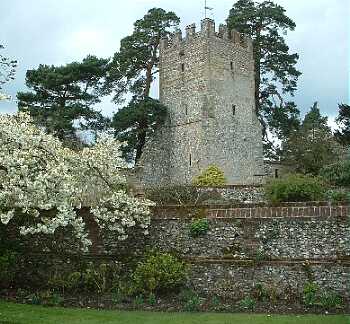
Grey's Court derives its name from Lord de Grey
who fought at Crecy and became one of the original Knights of the Garter. In 1347 Edward III granted Lord de Grey a licence to crenellate his house.
By the end of the 13th century the de Grey family were spread all over England with the Baron Grey's of Wilton and the Baron Grey's of Codnor being the senior members. They all went on to serve their King in Wales, Scotland and later in the Hundred Years War with France. In 1282 Longshanks crossed into Wales to put down the latest uprising which soon turned into a war of conquest. The de Grey's were all under Longshanks's banner and all were to be well rewarded for their services.
For such an old dwelling that has been constantly occupied, very little evidence has survived to tell us of its early history. In the Domesday book, Anchetil de Greye is described as owning Redrefield (Rotherfield). The de Greys also had lands in Norfolk and this line of the Family gave us John de Grey, Bishop of Norwich and justicular of Ireland who died in 1214. He served in King John's retinue from 1198. John had him elected Archbishop of Canterbury after Hubert Walter's death in 1205, but this was quashed by Innocent III and Stephen Langton was elected. By the end of the 13th century the de Grey family were spread all over England with the Baron Grey's of Wilton and the Baron Grey's of Codnor being the senior members. They all went on to serve their King in Wales, Scotland and later in the Hundred Years War with France.
|
The de Grey family continued to own the estate of Rotherfield for more than four centuries. In 1239 Walter de Grey, Archbishop of York, brought Rotherfield from his Kinswoman, Eve de Grey, in order to give it to his brother Robert de Grey, ancestor of the Lords Grey of Rotherfield. This Robert's Grandson, Sir Robert de Grey fought for Edward I in Wales in 1282/3.
In 1282 Longshanks crossed into Wales to put down the latest uprising which soon turned into a war of conquest. He intended to severely punish his rebellious vassels and finally put the country under his control. The English system of administration was extended, new counties were formed in the north and a consolidation of his Castle building began in earnest. It was during these campaigns that the more 'professional' soldier was being employed more and more by the King, or attending as part of a higher Nobles retinue. The de Grey's were all under Longshanks's banner and all were to be well rewarded for their services.
Sir Robert de Grey's son, John de Grey (1271-1312), was summoned to Parliament as first Baron Grey of Rotherfield on 26th January 1297. He took part in the Scottish wars under Longshanks and fought in the glorious victory at Falkirk in 1298 against William Wallace, when a large part of Edward's troops refused to fight. He was back in Scotland again in 1306 after the rebellion and enthronement of Robert Bruce. He died in 1312 having married Margaret, daughter of William de Odingsells of Maxstoke, Warwickshire and was succeeded by his son, John de Grey, second Baron Grey of Rotherfield (1300-1359). John de Grey was probably the most famous of the de Greys of Rotherfield. He was a professional soldier who:
'Received livery of his lands in the fifteenth year of the reign of Edward the second after the conquest'
|
In 1336 he was fighting for the King in Scotland; in 1342 he took part in the expedition to Flanders. He was in France in 1343, 1345-6, 1348 and again in 1356. He took part in the Battle of Crecy in 1346 with Edward III and his son Edward Black Prince of Wales, and it was after his return (after the fall of Calais in 1347) that he was given licence to crenellate Rotherfield. In 1353 he was commissioner of array for the counties of Oxfordshire and Buckinghamshire, and in 1356 was one of the witnesses to the charters by which Edward Baliol granted all his rights in Scotland to Edward III.
John de Grey was summoned to Parliament from 1326-1356 and was one of the Original Knights of the Garter instituted at its foundation in 1344 and confirmed in 1348, where he occupied the eighth stall on the sovereign's side at Windsor Castle. He died on 1 Sept, 1359 leaving Greys to his son, also John de Grey, Third Baron. The house was completely rebuilt during the life of John, 2nd Baron and his work was continued by his son John, 3rd Baron.
The 5th Baron Grey of Rotherfield, another John de Grey, also fought in the Hundred Years War for Edward III, and his splendid brass, dating 1387, can be seen in the lovely Rotherfield Greys Church, hidden beneath a carpet. He had no sons and his daughter, Joan, married into the Deincourt family. Her daughter, Alice, married William, Lord Lovell in 1422 and inherited Greys from her mother. Alice died in 1455 and with her son, Francis, (whose fate was never accounted for after the Battle of Bosworth ) the family's ownership and occupancy of Greys came to an end.
Jane Grey, the daughter of Henry Grey, the Marquess of Dorset, was born in 1537. During the final illness of Edward VI, Jane Grey was married to Guildford Dudley, fourth son of John Dudley, Duke of Northumberland, as part of the scheme to make sure of a Protestant succession.
Jane Grey was declared queen three days after Edward's death. However, she was forced to abdicate nine days later in favour of Edward's sister, Mary Tudor and was imprisoned in the Tower of London.
In 1554 Sir Thomas Wyatt and Henry Grey led a rebellion against Mary. As a result Lady Jane Grey and her husband, Guildford Dudley, were executed.
|